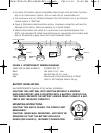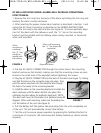MOBILE HOME INSTALLATION
Modern mobile homes have been designed and built to be energy efficient.
Install smoke alarms as recommended above (refer to RECOMMENDED LOCA-
TIONS and FIGURES 1 and 2).
In older mobile homes that are not well insulated compared to present stan-
dards, extreme heat or cold can be transferred from the outside to the inside
through poorly insulated walls and roof. This may create a thermal barrier
which can prevent the smoke from reaching an alarm mounted on the ceiling.
In such units, install the smoke alarm on an inside wall with the top edge of the
alarm at a minimum of 4” (10 cm) and a maximum of 12” (30.5 cm) below the
ceiling (see FIGURE 1).
If you are not sure about the insulation in your mobile home, or if you notice
that the outer walls and ceiling are either hot or cold, install the alarm on an
inside wall. For minimum protection, install at least one alarm close to the bed-
rooms. For additional protection, see SINGLE FLOOR PLAN in FIGURE 2.
WARNING: TEST YOUR SMOKE ALARM OPERATION AFTER R.V. OR
MOBILE HOME VEHICLE HAS BEEN IN STORAGE, BEFORE EACH TRIP AND
AT LEAST ONCE A WEEK DURING USE.
2. LOCATIONS TO AVOID
• In the garage. Products of combustion are present when you start your auto-
mobile.
• Less than 4” (10cm) from the peak of an “A” frame type ceiling.
• In an area where the temperature may fall below 40ºF (4.4˚C) or rise above
100ºF (37.8˚C), such as garages and unfinished attics.
• In dusty areas. Dust particles may cause nuisance alarm or failure to alarm.
• In very humid areas (greater than 85% R.H.). Moisture or steam can cause
nuisance alarms.
• In insect-infested areas.
• Smoke alarms should not be installed within 3 ft (.9m) of the following: the
door to a kitchen, the door to a bathroom containing a tub or shower, forced
air supply ducts used for heating or cooling, ceiling or whole house ventilating
fans, or other high air flow areas.
• Kitchens. Normal cooking may cause nuisance alarms. If a kitchen alarm is
desired, it should have an alarm silence feature or be a photoelectric type.
• Near fluorescent lights. Electronic “noise” may cause nuisance alarms.
• Smoke alarms are not to be used with detector guards unless the combination
(alarm and guard) has been evaluated and found suitable for that purpose.
1260-7205-01(820-0394G-EN)_v1.qxd:_ 2011.5.16 10:15 AM Page 4


















